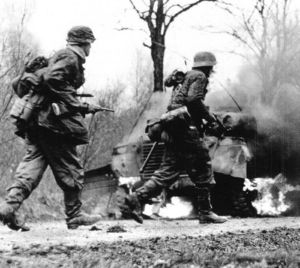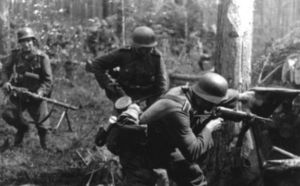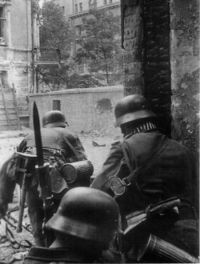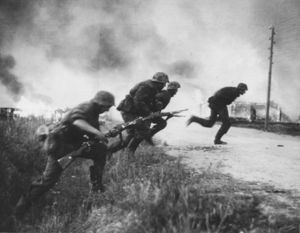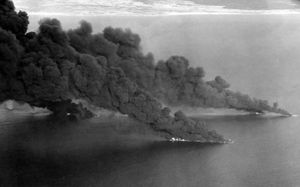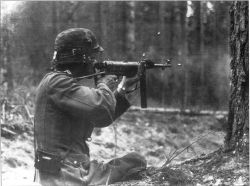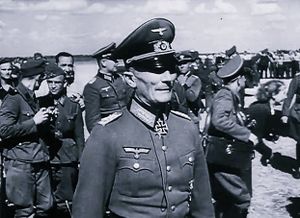10 Days War
| 10 Days War | |||||||
|---|---|---|---|---|---|---|---|
Two Panzergrenadiers of the Verteidigungsstaffel advance past a burning Porantan vehicle in the outskirts of Widerhausen, Hundermenschen |
|||||||
|
|||||||
| Belligerents | |||||||
| Porant Volsvakia |
||||||
| Commanders and leaders | |||||||
| President of Porant | ||||||
| Casualties and losses | |||||||
| Military Dead: 100,000 | Military Dead: 250,000 |
||||||
The 10 Days War was a conflict that began when Porant declared war on Hundermenschen due to the latter's lack of a democratic form of government. A "domino effect" resulted as several more nations were pulled into one of two sides. Initially, it seemed as if the attacking armies were going to be victorious, but as Hundermenschen called upon allies to assist, the invading forces were repulsed and forced to agree to peace out of fear of invasion themselves.
The short ten-day war inflicted hundreds of thousands of casualties on both sides. Hundermenschen received the most casualties out of all, due to their nation being the battleground in nearly all engagements.
Contents
Background
Porant was a strong country both politically and militarily that advocated strongly for democratic forms of government. The strong ties they held throughout their region and the world enabled them to meddle in matters globally, influencing foreign governments and decisions made in distant lands. Porant eventually took notice of Hundermenschen, a gigantic nation led by an autarch. Porant wished to flex its political muscles and demanded that Hundermenschen resort to a more democratic government, to which they received a negative reply. Tensions rose between the two nations as Porant repeatedly demanded for democratic rule in Hundermenschen. Hundermenschen continued dealing with its own internal issues (Hundermenschen was going through an intense drought at the time of this crisis) and ignored the barrage of threats from Porant.
Porant decided enough was enough and that matters had to be dealt with by force. Porant declared war on 17 January 1913 at 10:49 a.m.
Opening Hostilities
Porant Strikes First
Porantan Naval Forces began moving towards Hundermenschen a mere hour later. This was the beginning stage of Operation Groundforce, which the President of Porant personally designed. It entailed the Navy moving alone to the Northern Coastline of Hundermenschen, bombarding the cliff fortifications from the sea. Porant naval strength numbered two aircraft carriers, seventeen destroyers, two submarines, and fifteen military transport ships. This naval force was to be reinforced by the Porant Air Force which was tasked with overseeing the transport of troops onto the beach and up the cliffs.
The naval force assigned to invading Hundermenschen arrived at its destination around 3:20 p.m. The bombardment commenced immediately. The lightly-defended cliffs on the Northern Coastline sustained heavy casualties during the ensuing bombardment. The Porant Air Force arrived around 6:00 p.m. and immediately, along with the military transport ships, began ferrying troops onshore. Offloading troops sustained significant casualties due to the remaining defenders, although these losses were not substantial enough to halt progress. A beachhead was established by 8:30 p.m. Once word had been received by Hundermenschen High Command that such high damage had been done, Hundermenschen appealed to its allies for immediate assistance.
More Nations Join
After the initial strike on the Northern Coastline, Hundermenschen High Command realized the daunting task they were presented with. Luckily, The Goryevdre Islands realized the dire situation and came to assist. The Goryevdre Islands declared war on Porant and mobilized its Coast Guard and International Reaction Force. The latter was deployed to Hundermenschen the next day. Due to the Goryevdren principles of diplomacy, however, these troops would not be engaged in front line combat. They were to reinforce captured areas and assist in the maintaining of the logistic system employed by their allies.
Porant was not without her allies, either. The Union of Socialist Republics of Volsvakia, a trade partner of Porant, declared war on Hundermenschen. Volsvakia justified the act by claiming Hundermenschen to be a threat to international business.
Buildup of Forces
Arrival of the Volsvakians
Late in evening on January 17th the first vessels of the 7th Shock Fleet of the Volsvakian Navy began arriving in the waters off the Northern Coastline. A large force of nearly forty ships - which was comprised of two aircraft carriers, several battleships and cruisers, several frigates, over a dozen destroyers, and many more transport ships - began to reinforce the already present Porantan forces. The flagship of the Volsvakian Navy, the VNS Gegemoniya, led the Volsvakian 7th Shock Fleet. Volsvakian Admiral Yuri Verchenko immediately contacted the Porantan commander and organized a meeting to begin planning for the next phase of Operation Groundforce.
Rotgeheim Joins the Fight
Hundermenschen, realizing the humongous threat now looming over, contacted a new ally. Rotgeheim was alerted to the ever-growing threat of annihilation that Hundermenschen faced and announced internationally on January 18th, 1913 that they would be intervening on the defending side. The Verteidigungsstaffel, a quick-reaction force separate from the military of Rotgeheim, was immediately and hastily sent to Hundermenschen. Nearly 300,000 troops were sent within the first two days. Rotgeheim Naval Forces and Air Forces were mobilized and sent around the Western Coast of Hundermenschen. Their responsibility was to destroy the navies of Porant and Volsvakia and eliminate any attempt at allowing them to further reinforce the troops already ashore.
First Engagements of the Verteidigungsstaffel
Breaching the Porantan Defensive Perimeter
The nearly 300,000 troops of the 1st VS-Panzer Army (German: 1. VS-Panzerarmee) embarked upon the trek to engage the Porantan forces in the beachhead on the Northern Coast. The II VS-Panzerkorps (composed of the 1st VS-Panzer Division Kaiser Florian von Horn, 5th VS-Panzer Division Wiking, 11th VS-Panzergrenadier Division Selbstständigkeit, and 16th VS-Panzer Division Sturm) spearheaded the advance at the Porant forces. Unbeknownst to the Rotgeheim troops, however, the Porant forces had advanced nearly 50 km outside of the beachhead and were established in a spherical defensive position around the landing site.
The first engagement occurred early in the morning of January 20th, 1913. The 5th Reconnaissance Battalion of the 5th VS-Panzer Division Wiking encountered infantry (later revealed to be an infantry regiment) in a small village and fighting broke out between the two sides. The Rotgeheim troops radioed for help and nearby troops of the 1st VS-Panzer Division Kaiser Florian von Horn arrived at the battle scene. Porantan forces were quickly outnumbered as the technologically superior Rotgeheiman troops poured into the battle zone. The combined infantry and armor assaults by the 1st VS-Panzer Division and the 5th VS-Panzer Division allowed for the encirclement and destruction of defending Porantan forces. This battle came to be known as the Battle of Bloody Gulch, as many retreating Porantan units were herded into and subsequently destroyed in a low area between two roads. This engagement allowed for a 12 km-long incision to be sliced into the Porantan defensive perimeter by the II VS-Panzerkorps. This allowed for a definitive line to be drawn between the Porantan forces trying to maintain their beachhead and the attacking Rotgeheiman troops.
In the early hours in the afternoon of January 20th the lead battleships and superdreadnoughts of the Rotgeheiman 1st Fleet encountered a small Porantan and Volsvakian convoy of three transport ships escorted by two destroyers just outside the North-western Coast of Hundermenschen. The extreme range of the 20" guns possessed by the Hornung-class battleships in the Rotgeheim Navy vanguard was able to easily sink the slow-moving transport vessels before the escorting destroyers were able to intervene. The two destroyers then moved to engage the attacking Rotgeheiman Navy battleships and superdreadnoughts.
By 10:00 that evening the entirety of the flotilla assigned to engage the ships off the Northern Coast had assembled 100 km from their adversaries. Naval vessels of The Goryevdre Islands also began to trickle in around 12:00 a.m., with the remainder of the International Reaction Force reaching the rallying zone by 3:00 a.m. A sizable naval task force had now been assembled that numbered just over fifty vessels. Three aircraft carriers of the Rotgeheim Navy were also transporting several squadrons of fighters and dive-bombers of the Rotgeheim Air Force, with more planes expected to land at airstrips in Southern Hundermenschen the next day.
Further Attacks
Arrival of the XII and XIV VS-Panzerkorps
As the II VS-Panzerkorps bolstered its defensive area in the 12 km-long incision into Porantan territory the XII VS-Panzerkorps and the XIV VS-Panzerkorps arrived to reinforce troops already there. The addition of six new divisions (in the XII VS-Panzerkorps were the 9th VS-Panzer Division Hohenstaufen, 10th VS-Panzer Division Fuerstenburg, and 14th VS-Panzergrenadier Division Balkan; in the XIV VS-Panzerkorps were the 17th VS-Panzergrenadier Division Furtwängler, 24th VS-Panzergrenadier Division Maria Theresia, and 27th VS-Panzer Division Finnmarck.) significantly improved the chances of success for the attacking Rotgeheiman forces. On the 22nd of January Fall Rot (the code name for the next stage in the ground operation to repel the invading Porantan forces) was to begin.
Fall Rot Begins
At 5:30 a.m. on 22 January the offensive began. A three-pronged attack was planned, with the XII VS-Panzerkorps attacking on the left, the II VS-Panzerkorps in the center, and the XIV VS-Panzerkorps on the right. Fall Rot was broken up into a series of different objectives, with the ultimate goal of ridding Northern Hundermenschen of the invading Porantan forces. The first objective was encircling and destroying a large concentration of Porantan infantry and armor centered around the city of Widerhausen. Each VS-Panzerkorps was assigned a different goal during this opening phase.
- The XII VS-Panzerkorps was to assault left and eliminate all opposition in the way until reaching the Tiroler River – assuming the main bridge was intact, crossing would immediately begin, but if not, then Pioneers would arrive behind the advance guard to create a pontoon bridge. After crossing the Tiroler River the XII VS-Panzerkorps was to hook right and cut off the northern side of Widerhausen. From then on the Panzerkorps would be responsible for containing any breakout attempts the garrisoned Porantan troops would attempt to make, as well as repelling any relief efforts from the north.
- The II VS-Panzerkorps was tasked with assaulting the southern side of Widerhausen. All defending forces in the suburbs were to be destroyed. After eliminating all opposition to the forces defending the outskirts of Widerhausen, the II VS-Panzerkorps would then assault the city itself. Artillery bombardments would precede advancing into the city.
- The XIV VS-Panzerkorps was ordered to attack and destroy all enemy formations while making its way to a hilltop just before a tributary of the Tiroler River. Once reaching this area, the Panzerkorps was tasked with swinging left and advancing past the defending XII VS-Panzerkorps. Once past their defensive formations, the Panzerkorps was responsible to pushing back all relief efforts to the besieged garrison in Widerhausen.
The XIV VS-Panzerkorps made it to their objective and repelled all subsequent relief efforts by Porantan forces. Widerhausen surrendered in the early hours of 24 January. Rotgeheiman forces now occupied a 30 km-deep, 25 km-wide salient in Porantan territory. The beachhead was now less than 20 km away.
Preparation Second Stage of Fall Rot
After the quick destruction of Porantan garrison at Widerhausen the next stage of the operation was to commence. The II, XII, and XIV VS-Panzerkorps were once again assigned individual objectives. Each formation was tasked with seizing a small town, which when all connected into a defensive perimeter, would encircle the Porantan forces at their beachhead. The Rotgeheim Air Force and the Wings of the VS were now able to give close support due to the two newly-acquired airstrips in Widerhausen. The second stage was set to begin at 5:30 a.m. on January 24th, 1913.
- The II VS-Panzerkorps was tasked with assaulting northward to the small town of Elssler. VS-Fighter Wing 2 Schwarze Ritter and VS-Ground Attack Wing 7 Schwarze Schafe were to support the advance. Once the town had been taken, a defensive perimeter would be set up and the Panzerkorps would await reinforcements.
- The XII VS-Panzerkorps was responsible for heading northeast and engaging the Porantan forces defending the town of Neuhäusser. VS-Fighter Wing 1 Wächter and VS-Ground Attack Wing 8 Kater would be in support. As with the II VS-Panzerkorps, the XII was to establish a defensive perimeter around the town and await reinforcements.
- The XIV VS-Panzerkorps was ordered to seize the town of Grünberg on the northwest prong of the attack. A Fighter Wing and Ground Attack Wing of the Rotgeheim Air Force were assigned to the XIV VS-Panzerkorps during the advance. As with the previous two Panzerkorps, the XIV was to defend the town once taken and await reinforcements.
The Second Stage Commences
The II VS-Panzerkorps departed their positions at 6:00 a.m. on the 24th, which was later than instructed. This was not to cause problems, however, as the Porantan forces were in no position to take advantage of this delay. The 5th VS-Panzer Division Wiking led the way with its heavy complement of PzKpfw XI Ausf. B Königspanthera. Enemy resistance was stiff on the way to the II VS-Panzerkorps' objective, but these tanks eased the advance. Although few in number, the heavy-caliber gun and impenetrable armor of the Königspanthera ensured that all opposing forces would be destroyed. A path was bulldozed through Porantan fortifications and the Panzerkorps arrived at Elssler at 6:45 a.m. The subsequent fighting was quick and brutal, with Panzergrenadiers storming through the streets at the retreating Porantan as fighters and dive bombers strafed the fleeing troops. Rotgeheiman troops managed to advance up center road and slice the Porantan formation in two, after which Porantan forces were encircled. Fighting intensified throughout the evening of the 24th, but almost all Porantan units had been mopped up by the early hours of the 25th. The town was officially reported as seized by late morning of 25 January.
The II, XII, and XIV VS-Panzerkorps of the 1st Panzer Army stationed around Elssler, Grünberg, and Neuhäusser were ordered to dig in and defend the line stretching across the three towns. The IV VS-Panzerkorps (composed of the 12th VS-Panzer Division Strahlfeld, 18th VS-Panzergrenadier Division Nordland, and 37th VS-Panzer Division Rote Teufel) arrived in Widerhausen early in the morning on the 24th and would reinforce the II VS-Panzerkorps in Elssler. The offensive was scheduled to renew upon the arrival of the three new divisions. The beachhead was a mere 10 km away at this point.
Destruction of the Volsvakian Fleet
Although the Volsvakian 7th Shock Fleet was a sizable force, it was not a particularly advanced nor well-trained one. The aerial defenses on the ships were sub-par when compared to those used by the Rotgeheiman and Goryevdren navies, and the aircraft utilized by the naval aviation corps of Volsvakia was not much better. The coming battles would prove these notions as fact.
In the late evening of January 22nd the lead battleships of the Rotgeheiman 1st Fleet, accompanied by four aircraft carriers and led by the RKM Kirchmeyer, began to head toward the left flank of the anchored Volsvakian Navy (this group was designated Battle Group A) The vanguard of ships hooked around the left flank and managed to loop around to the northern side of the anchored ships before being spotted. By the time the Volsvakian Navy was alerted to the presence of the Rotgeheiman Navy, the rest of the flotilla (designated Battle Groups B and C for this engagement) had begun to move forward towards the southwestern flank of the Volsvakians. The Goryevdren forces, with their agile fast-moving cruisers and gunboats, zipped in and out of the farthest out ships of the Volsvakian Navy. While these ships tried to defend themselves against the gunboats, the Rotgeheiman superdreadnoughts fired their salvos at the vulnerable Volsvakians. The first shots tore the ships apart. Within the first hour the Volsvakian Navy lost eight of its twenty battleships with only two Rotgeheiman losses (both were cruisers). More Volsvakian ships arrived to stop the naval juggernaut that was the oncoming force of Rotgeheiman and Goryevdren ships, all the while leaving their left flank less defended than it should have been, and thereby exposing the command ships in the center.
The RKM Kirchmeyer deployed its dive bomber wing stationed on board as soon as the engagement to the south began. It then retreated to safety, guarded by a battleship and several cruisers. The planes of the dive bomber wing were tasked with destroying the smaller Volsvakian ships and damaging the bridges of the larger ones (since the Ju87-f dive bombers carried only a 600 kg bomb that was unable to sink the larger ships, the pilots were instructed to aim for weak areas like the bridge or the main guns themselves). The battleships in Battle Group A then began engaging the Volsvakian vessels on the left flank. Out of the three battleships and seven destroyers on the left side, only two destroyers survived the engagement. Among the ships destroyed was the VNS Gegemoniya, the flagship of the Volsvakian Naval Forces and subsequently holding much of the naval staff of the 7th Shock Fleet, including Volsvakian commander Admiral Yuri Verchenko. Ju87-f dive bombers that returned from engaging the core of the Volsvakian Navy were reassigned to support Battle Group A. The added assistance from the dive bombers ensured the already-damaged vessels were sunk with relative ease.
After the left flank completely collapsed, the remaining Volsvakian ships engaging Battle Groups B and C immediately began to retreat. Battle Groups A, B, and C chased the Volsvakian ships falling back, crippling and destroying any vessel possible. This engagement left over half ships in the Volsvakian Navy either crippled beyond function or destroyed. Only eighteen ships were available for combat, and those were hastily retreating towards the northern flank of the Porantan Navy ships off the Northern Coast of Hundermenschen. The Rotgeheim Navy did not continue pursuing the fleeing ships past 2:00 a.m. on January 23rd, but the Rotgeheim Air Force continued attacking throughout the night.
Retreat of the Volsvakians
After the near-annihilation of its vessels, the Volsvakian Navy High Command sought out of the war. Billions of dollars had already been lost, as well as irreplaceable men and materiel. The Volsvakian public, once informed of the disaster that took place, immediately wanted out of the conflict. The Volsvakian leader had no choice but to pull out all remaining vessels guarding the Poratan beachhead on the Northwestern Coast of Hundermenschen and abandon their ally. The last Volsvakian ship departed the Northwestern Coast in the early hours of 24 January.
The Porantan reaction, unexpectedly, was more than displeased. The President of Porant verbally assaulted the leader of Volsvakia for quite some time of a phone call about the matter, although to no avail. Volsvakian command had made up their mind and pulled what forces were left out of the Hundermenschenian waters for good. Porantan forces now had to carry the entire weight of the war on their shoulders.
Renewing the Offensive
Arrival of the IV VS-Panzerkorps
On the 25th of January the II, XII, and XIV VS-Panzerkorps were concentrated around the towns of Elssler, Grünberg, and Neuhäusser, respectively (minor engagements were still taking place in Elssler, but for the most part they were not a problem enough to stall the advance of the 1st VS-Panzer Army). The three armored corps formed a line creating a semi-circle around the Porantan beachhead. This line was dubbed the Steinweg Line and was ordered to be held at all costs until the arrival of the IV VS-Panzerkorps on the 25th.
Porantan counterattacks were expected by the entrenched Rotgeheiman troops, but none were actually initiated. The retreating Porantan forces did not have the organization to form their men into cohesive units and fight back at this stage in the war. The momentum they had in the first few days was now lost.
Early in the morning on the 25th, the IV VS-Panzerkorps arrived with three divisions fresh from the loading docks (namely the 12th VS-Panzer Division Strahlfeld, 18th VS-Panzergrenadier Division Nordland, and 37th VS-Panzer Division Rote Teufel). The newly-arrived Panzerkorps was assigned to reinforce the II VS-Panzerkorps in Elssler and await further instruction.
Preparation for Stage Three of Fall Rot
Now that the II, IV, XII, and XIV VS-Panzerkorps were all together (making the total strength for the Rotgeheiman 1st VS Panzer Army at 13 divisions) on the Steinweg Line planning for the next phase of the offensive could commence. As with the previous stage of the operation, each Panzerkorps would be delegated a small series of objectives that, once all completed, would achieve success across the Northwestern Coast of Rotgeheim. Air wings of the Rotgeheim Air Force and Verteidigungsstaffel would be assisting the units on the ground. For the first time in the entire campaign, the forces of Hundermenschen would be assisting Rotgeheiman troops, which would appear on the battlefield in the form of the 2nd Fighter Wing, 4th Dive Bomber Wing, and 18th Bomber Squadron.
- The II VS-Panzerkorps (four divisions) was paired with the IV VS-Panzerkorps (three divisions) and was tasked with thrusting up the middle 10 km to attack the bulk of the Porantan forces head-on. The five armor divisions between the two Panzerkorps would form a V-shaped formation as the spearhead of the movement. The accompanying two Panzergrenadier divisions, as well as the attached Panzergrenadier regiments in the armor divisions themselves, would be responsible for advancing up and securing the line.
- The XII VS-Panzerkorps (three divisions) would be advancing alongside the II and IV VS-Panzerkorps and was responsible for securing the western flank of the assault. Minimal resistance was expected from the retreating Porantan troops. Once the XII VS-Panzerkorps reached the beachhead along with the II and IV, it would assist in assaulting the area.
- The XIV VS-Panzerkorps (three divisions) would be tasked with advancing eastward to the cliffs before hooking northwest and following them to the beachhead. This Panzerkorps would have the vital task of flanking the Porantan forces defending the beachhead.
- Air support was to be provided by several air wings of the Rotgeheim Air Force, Verteidigungsstaffel, and Hundermenschen Air Force. The airspace of the 10 km-deep, 15 km-wide semi-circle around the beachhead was to be given air support from the air wings of the aforementioned organizations. Of the Verteidigungsstaffel, VS-Fighter Wing 1 Wächter, VS-Fighter Wing 2 Schwarze Ritter, VS-Ground Attack Wing 7 Schwarze Schafe, and VS-Ground Attack Wing 8 Kater would be supporting the advancing forces. The Rotgeheim Air Force only dedicated a single fighter wing and ground attack wing. The Hundermenschen Air Force dedicated the 2nd Fighter Wing, 4th Dive Bomber Wing, and 18th Bomber Squadron.
Stage Three Begins

A half hour later the first planes of the forward fighter squadrons flew over the waiting divisions of the II and IV VS-Panzerkorps sitting in the center of the Steinweg Line. The divisions of the two armored formations immediately began moving out when they saw this. A few minutes later, the 18th Hundermenschen Bomber Squadron (which was part of a preemptive strike initiated by Hundermenschen to pulverize the awaiting Porantan defenders) flew its planes over the XIV VS-Panzerkorps. The XIV VS-Panzerkorps relayed they were moving out to the XII VS-Panzerkorps, which then began moving towards its objective.
Initially, no Porantan defenders were to be seen on any of the two attacking fronts. At roughly 5:00 a.m., however, first contact was made by the 1st VS-Panzer Division Kaiser Florian von Horn. The lead tank in a column of armor had run across mines, and immediately thereafter an ambush occurred. Rotgeheiman infantry accompanying the armor were mowed down alongside the PzKpfw XI Panthera tanks, and although the vehicles did their best in trying to repel the attacking Porantan troops, it was no use. Porantan troops overran the armor column and killed many of the troops in the immediate area. The few surviving Rotgeheiman troops fled back to the next armor column and alerted them to what just occurred.
The advance of Kaiser Florian von Horn had now stalled. While the troops from the ambushed armor column were still regrouping, more armor from Wiking and Sturm advanced towards the Porantan forces. Obsolete Porantan tanks and light armored vehicles met the Rotgeheiman armor formations and close-range fighting ensued. Although the Porantan defense was valiant, the sheer firepower of the Rotgeheiman tanks made quick work of the defenders' vehicles.
Final Engagements
Rotgeheiman Armor Advance
Across the Northwestern Coast of Rotgeheim, the many armor formations of the II, IV, XII, and XIV VS-Panzerkorps drove forwards to meet the demoralized Porantan enemy. Porantan armored strength was grossly overestimated by Rotgeheiman commanders, and as such the overwhelming Rotgeheiman armored vanguard plowed through the defenders with relative ease.
The XII VS-Panzerkorps, which was responsible for the western flank of the advance, met the least resistance out of all of the Rotgeheiman corps-sized units. The first PzKpfw Panthera tanks of Hohenstaufen spotted the static defensive positions on the cliffs overlooking the beaches on the coast of Hundermenschen at around 10:00 a.m. (the lengthy approach to the coast was because of the division commanders' tendency to slowly advance in fear of getting surrounded by enemy forces). The Fuerstenburg and Balkan caught up quickly, but because the other corps-sized armor formations had not made enough progress for the final assault to commence, the XII VS-Panzerkorps was ordered to wait until all Panzerkorps were ready. At 11:00 a.m. the entirety of the XII VS-Panzerkorps was amassed in a defensive ring, waiting for the rest of the 1st VS-Panzer Army to fulfill their objectives.
The XIV VS-PanzerkorpsThe II and IV VS-Panzerkorps met less resistance than anticipated. The bulk of the Porantan strength had been envisioned to be awaiting the arrival of Rotgeheiman troops in the center, but over the previous night most of the defending Porantan soldiers were pulled back to the cliffs overlooking the beach on the coast, with another section pulled eastward (which ended up being some of the troops engaged by the XIV VS-Panzerkorps at Roemheld). The only major resistance that stood before the II and IV VS-Panzerkorps was the few remaining armor and anti-tank troops. The flat land of the coastline, however, did not allow the defending Porantan troops to have much cover, which enabled Rotgeheiman and Hundermenschenian air support to decimate the defenses before ground forces encountered them. A small contingent of Porantan fighters attempted to strafe advancing infantry, but without success - they were cut to ribbons by the encircling fighters of the air wings of Hundermenschen and the Verteidigungsstaffel. At 2:00 p.m. the two Panzerkorps reached the line established on the western and eastern flanks by the XII and XIV VS-Panzerkorps, respectively.
The 1st Fleet of Rotgeheim and the Goryevdren International Reaction Force utilized the days since their last engagement to refit and recuperate. Battle Groups A, B, and C of Rotgeheim were still active at the time of the advancement in naval operations. The next step in the naval theater of the war, Rotgeheiman Naval High Command thought, was to eradicate the ability for Porant to wage maritime combat. The aircraft carriers were to play less of a role in this naval engagement, as the heavy cruisers and superdreadnoughts were to lead the battle, but they were to be utilized nontheless.
At 12:00 p.m. on 24 January the three Battle Groups departed from their holding location and headed towards the Porantan Fleet stationed off the coast of Hundermenschen. Battle Group A (with Goryevdren forces attached) led the advance with the largest complement of heavy cruisers and superdreadnoughts, with Battle Groups B and C trailing (the latter two contained all four aircraft carriers with two assigned to each) closely behind. At roughly 12:30 p.m. the lead heavy cruisers and superdreadnoughts of Battle Group A spotted the first ships of the Porantan Navy, and at 12:40 p.m. they came within firing distance.
The Porantan ships spotted the Rotgeheiman and Goryevdren attackers and immediately began firing westward to warn them off, however, the range of the Porantan cannons were nowhere near the distance the ships of Battle Group A were away. The 20" guns of the Rotgeheiman Hornung-class battleships retaliated at the Porantan fleet; the shells of the 20" guns easily struck the sides of the Porantan ships,
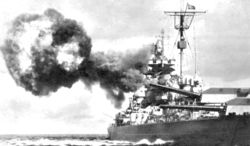
heavily damaging one and permanently crippling another ship in the first volley. About four Goryevdren destroyers rushed out to attack the Porantan ships, easily maneuvering around the incoming shells, to engage the easy prey. Goryevdren ships sunk both of the ships that were hit during the first volley, as well as sinking two more smaller Porantan craft. The bulk of the Porantan strength immediately began to retreat from the vicinity. Before they could retreat few more Porantan ships were sunk by the quick, nimble Goryevdren vessels. Hearing the news of the retreating Porantan ships, the aircraft carriers of Battle Group B rushed their fighter-bombers into the sky as quickly as possible in hopes of further crippling Porantan naval strength. A small number of carrier aircraft caught up with the retreating formation and were able to engage them for a short period of time, but not enough aircraft was present to inflict major damage.
The Porantan Fleet continued its drive out of the battlespace throughout the night, and although much thought was given about the matter, the Porantan President ordered the remaining vessels to return home. Porantan ground forces were now stranded on the beachhead and on the surrounding cliffs.
Surrender of Porantan Forces
The XII, II, IV, and XIV VS-Panzerkorps positioned themselves in another defensive line a mere two kilometers away from the cliffs. The thirteen divisions of the 1st VS-Panzer Army were told to remain in the defensive formation for the duration of the night on 26 January. On 27 January, after the defeat of the Porantan naval strength in the waters off Hundermenschen, it was decided that the 1st VS-Panzer Arm was to continue remaining in its defensive positions until the following day. Rotgeheiman forces were fully rested and recuperated by this point, and reinforcements from the replacement depot established in Widerhausen were all received. The Porantan commander on the cliffs, however, approached the defending Panzergrenadiers of the 24th VS-Panzergrenadier Division Maria Theresia with a white flag in hand, willing to negotiate terms of surrender. It was later revealed that a Rottenführer Baldur Lichtenberger, a Northern Prussian soldier serving in the Verteidigungsstaffel, was originally going to fire upon the group approaching the lines, although he did not out of simple curiosity.
The commander of the Porantan forces in the cliffs off the Northwestern Coastline of Hundermenschen negotiated terms of surrender first with Generalmajor August Zehender, the commanding general of the 24th VS-Panzergrenadier Division Maria Theresia, however, once it was ascertained that the entirety of Porantan forces were to be laying down their arms, surrender terms were negotiated with the commanding general of the 1st VS-Panzer Army, General der Panzertruppe Fritz Hahnemann. Rotgeheiman forces wished only for an unconditional surrender, and as the Porantan forces were in no place to bargain, they accepted. Porantan forces in Hundermenschen surrendered officially at 4:00 p.m. on 27 January. Porantan troops continued to surrender throughout the night of 27 January and into the next few days.
Aftermath
The 10 Days War was the first Rotgeheiman conflict in which the Verteidigungsstaffel was battle tested. The formation proved itself to be an effective, cohesive fighting force capable of defeating the enemy. Rotgeheiman Supreme High Command previously doubted the effectiveness and necessity of the Verteidigungsstaffel, but the 10 Days War was enough to silence those doubts. The funding for the Verteidigungsstaffel in the coming years was ensured to be well higher than it previously had been, and the quality of equipment was to be improved to fit the needs of such a rapid fighting force.
Immediately following the 10 Days War, the vast numbers of prisoners interned by Rotgeheiman forces during the war required many hours and plenty of funding. In order to improve the effectiveness of the Verteidigungsstaffel, the Rotgeheiman government issued an order that offered Porantan soldiers, lower-ranking non-commissioned officers, and junior officers to join the Verteidigungsstaffel. The prisoners were required to have served at minimum term of two weeks within the prison system before applying for acceptance. A medical examination, as well as an educational standardized test were also prerequisites (funded for and provided by Rotgeheim) for admittance into the Verteidigungsstaffel. It is suspected that as many as 50,000 ex-Porantan troops applied for service in the Verteidigungsstaffel, with about 40,000 being accepted. Many Porantan troops were assigned to the numerous divisions already in the Verteidigungsstaffel, but a few new divisions of various types were also created in order to provide for the large numbers of incoming recruits. For the most part, incoming Porantan soldiers kept their rank in their previous military service; only few examples exist in which this is untrue, with this cases mostly having Porantan soldiers being bumped down a rank. Porantan troops that fulfilled their service term of 10 years were offered the option of acquiring citizenship. Many are expected to apply to become Rotgeheiman citizens.
Porant officially ended the war on 27 January 1913. Rotgeheiman forces did not pursue Porantan forces any further, although Porantan leaders had assumed so. Because of the devastating losses suffered by Volsvakia and Porant during the war, both nations ceased to exist -similar ends were met by both countries. Volsvakia went through a very sharp decline in its economy, which triggered riots and an eventual revolution that resulted in anarchy. Porant also suffered a sharp drop in its economy, which triggered armed groups to rise up against the government, beginning a civil war, and eventually leading to the existence of the country to cease. Hundermenschen thankedthe governments of Rotgeheim and the Goryevdre Islands immensely and offered payments in various ways, but both nations did not accept. Kaiser Rudolf Geske addressed Rotgeheim on 29 January 1913 about the war, saying, "It was duty as nation to come to the aid of Hundermenschen because it is our duty as a nation to ensure that the tyranny of unwarranted acts of aggression be halted wherever it may rise; it will forever be our duty to come and assist the nations in need, especially our dear allies like our grateful friends in Hundermenschen."
Order of Battle
Composition of Rotgeheiman Forces
At the conclusion of hostilities, the following Rotgeheiman forces were present in Hundermenschen:
Ground Forces
1st VS-Panzer Army (1. VS-Panzerarmee) (Fritz Hahnemann) with 13 divisions:
- II VS-Panzer Corps (II VS-Panzerkorps) (Bernhard Schlessinger)
- IV VS-Panzer Corps (IV VS-Panzerkorps) (Eckhardt Baumstein)
- XII VS-Panzer Corps (XII VS-Panzerkorps) (Siegfried Feilhaber)
- XIV VS-Panzer Corps (XIV VS-Panzerkorps) (Oliver Rauschenberg)
1st Fleet (1. Flotte) (Raphael Schädler) with about 40 ships:
- Battle Group A (Kampfgruppe A) (Kilian Herreshoff)
- Battle Group B (Kampfgruppe B) (Siegfried Sauerbrunn)
- Battle Group C (Kampfgruppe C) (Johann Edelstein)
Air Forces
VS-Air Fleet 1 (VS-Luftflotte 1)
- VS-Fighter Group 1 (VS-Jagdgruppe 1) (Heinrich Stahlschmitt)
- VS-Ground Attack Group 4 (VS-Sturzkampfgruppe 4) (Eberhard Hoenig)
